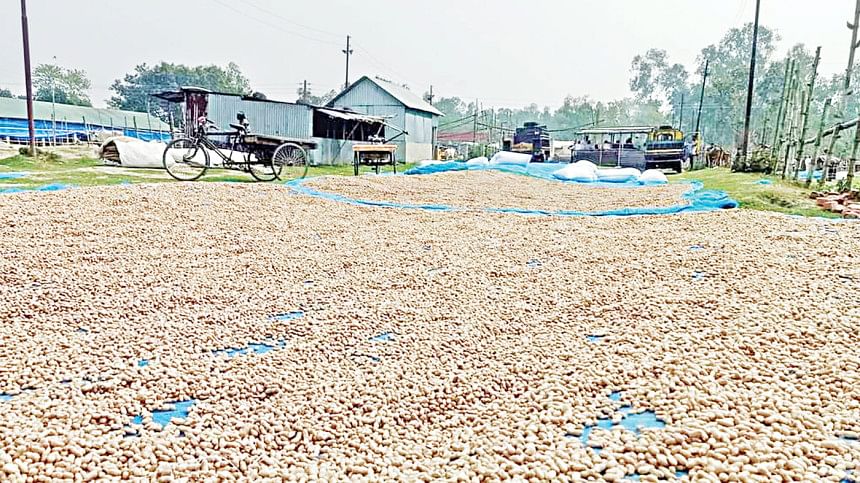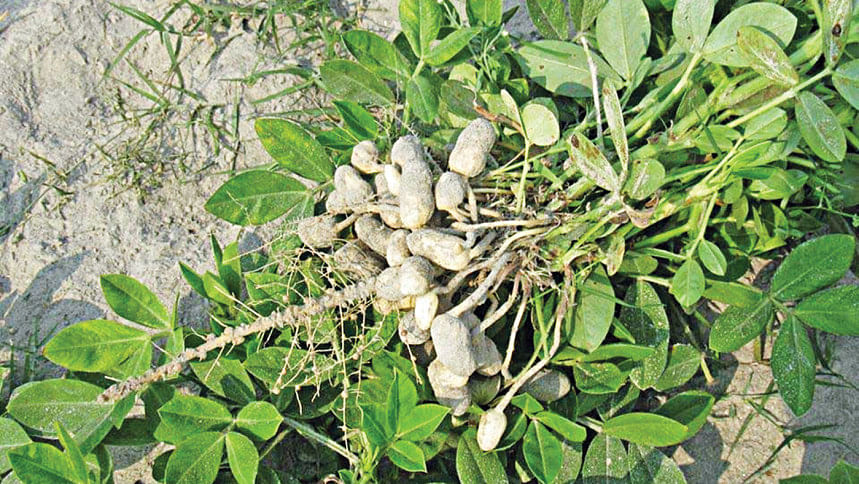Peanut emerging as a major cash crop

The ever popular peanut has maintained a steady uptick in consumption for many years now, turning it into a major cash crop for local growers, especially those in char areas along Jamuna River in Tangail.
Peanut farmers in the region are pleased to be getting higher prices for their product this year as people are increasingly consuming the legume crop and its derivatives for health benefits.
Peanut, also called groundnut, is a short-term cash crop and an excellent edible oilseed.
They are a very good source of vegetable protein, and contain a lot of unsaturated fats and magnesium.
Peanut cultivation in the sandy char areas is more profitable and simpler compared to other crops.
Peanuts are grown on nearly 1 lakh hectares of land in the country each year to produce around 1.5 lakh tons of the legume, according to sources in the agriculture ministry.

However, this amount caters to just one-third of the local demand while the rest is imported.
There is ample opportunity to correct the situation though by increasing peanut yields through the application of advanced technology, the sources said.
Data from the Department of Agricultural Extension (DAE) in Tangail shows that peanuts have been cultivated on about 2,201 hectares of land in the district this season.
The post-flood soil in char areas is suitable for getting better yields of the oilseed, and that is why most of the crops have been planted in upazilas that border Jamuna River.
As such, the highest cultivation is taking place in the region's Bhuyanpur and Sadar upazilas, where peanuts are being grown on 1,722 hectares and 375 hectares of land respectively.
Meanwhile, 28 hectares in Gopalpur upazila, 20 in Basail upazila, 20 in Kalihati upazila, 14 in Delduar upazila, 9 in Ghatail upazila, 7 in Nagarpur upazila, 5 in Sakhipur upazila and 1 in Mirzapur upazila are being used to cultivate the crop.
The Bri-7 and Bri-8 varieties are the most widely cultivated while the Bina-4 and BG-2 varieties are also quite popular.
Local farmers say peanut plants mature within 120 to 150 days of sowing. In the Jamuna char areas, peanut cultivation starts from the end of September while harvests begin from the first of January.
During a recent visit, it was seen that the harvesting of peanuts in char areas of Bhuyanpur upazila has been almost completed.
Local farmers were busy drying their harvests under the sun before sending them to markets with help from the women and children in their families.
Farmer Mohor Ali, a resident of the upazila's Gabsara union, said that peanut plants do not require much care after sowing unlike other crops.
"No need to use chemical fertilisers. There is no cost other than the labour cost of sowing seeds and harvesting peanuts," he added.
Azmat Miah of the same village said he cultivated peanuts on two bighas of land this season.
"I hope to get at least Tk 30,000 as profit from the cultivation after excluding all costs," he said.
Al Amin, another peanut grower in the upazila, said local farmers were getting good profit from cultivation this year as peanuts were selling for Tk 2,800 to Tk 3,200 per maund (37 kilogrammes) at local markets.
However, the price per maund was Tk 2,200 to Tk 2,400 last year, he said.
Apart from harvesting peanuts, the plants can be used as cattle feed and fuel.
"Farmers can earn a few thousand extra by selling these," Amin added.
Peanut cultivation is increasing in char areas of Jamuna River each year as farmers are benefiting from the cultivation, said Humayun Kabir, upazila agriculture officer in Bhuyanpur.
He went on to say that the DAE assists peanut growers every year with free seeds and technical advice.

 For all latest news, follow The Daily Star's Google News channel.
For all latest news, follow The Daily Star's Google News channel. 



Comments